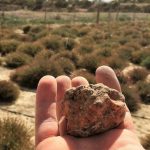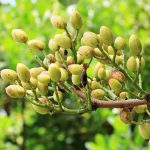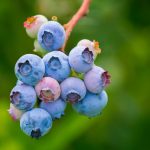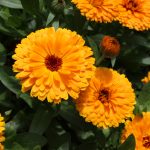
PROFITABLE AND GROWING CROPS: HOPS
Hops are one of the main ingredients of beer, being the element that gives it its aroma and, fundamentally, its characteristic bitter taste, although each of the different varieties contributes distinctive elements, acting as a counterbalance to the sweetness of the barley malt. It also makes the beer’s foam much more stable, improves its shelf life and gives it certain properties. Lupulin, an amber-coloured substance, is obtained from the flowers of the female plants, which are gathered in clusters of cone-shaped flakes after a drying process. Its use was enshrined in what is known as the Purity Law, decreed in 1516 by William IV of Bavaria, which specified that beer could only be made from three ingredients, namely water, malted barley and hops. Currently, its cultivation in Spain does not cover the national demand, which means that a large part of the national producers have to import up to 50% of the total amount of this raw material each year. Production is concentrated in Castile-Leon, Catalonia, La Rioja and Galicia.
General characteristics
The hop (Humulus lupulus) is a perennial climber, i.e. during the winter its stems and leaves dry out and then sprout again in spring. It is a member of the Cannabaceae family and can grow up to 12 m high in the wild. In agriculture, its growth must be limited in order to ensure the correct performance of various tasks, such as harvesting, pest and disease control methods and pruning. It sprouts annually from a woody rhizome that is buried in the soil. Its average life span is between 12 and 15 years, although there are references to plantations that have exceeded 25 years, with a production level maintained over time. Although production is obtained from the first year onwards, it is not until the third year that the highest levels are reached. In spite of being a climbing plant, it does not have tendrils or any other appendage for this purpose, using robust stems with rigid trichomes with which it can fix itself to the corresponding support. As a result, the provision of a trellising system is essential in agricultural crops, thus ensuring vertical development. It is a task that requires a certain degree of skill and knowledge, since the correct growth of the plants depends on it. What is done is to select from among all the shoots only those of intermediate development, eliminating the rest. The reason for this choice is that if the most vigorous shoots are selected, there may be strong competition between them for resources, while the smaller ones may not be vigorous enough to reach the wire fence. The different varieties can be classified as bitter, aromatic and mixed, depending on the characteristics they provide. In recent years, different studies have been carried out with molecular markers, trying to determine which specific varieties have the best properties in relation to beer production and the best disease resistance.
The root system is branched and deep, colonising the soil up to 2-3 m deep, with two clearly differentiated parts, which are the pivot part, located in the upper zone, where the buds or dormant shoots are located; and the deep part, made up of the rest of the vertical roots, which is responsible for root development and in which nutrients are stored. The lateral roots can move approximately 2 m away from the central axis of the plant.
Its leaves, with 3 to 5 oval, toothed lobes, are opposite. The upper side has a rougher texture, while the underside has a series of resinous glands.
It is a dioecious species, which means that male and female flowers develop on separate plants. The male flowers are grouped in panicles and have a groove in the anthers, where the resin glands are located. The female flowers are arranged around a central axis (rachis), which thickens over time, producing the strobilus (cone), which is the shape in which the plant is marketed. From the point of view of agricultural production, priority is given to the cultivation of female stalks, since it is from these that the inflorescences from which the lupulin is produced are obtained. The male plants are arranged in order to encourage pollination, which is anemophilous (wind), and are also used in research and variety improvement studies. Lupulin is a resin mixture consisting of α and β acids, volatile essential oils and polyphenols. Of these, the α-acids are responsible for the bitter taste of beer and are composed of three molecules known as humulones, the most important of which is cohumulone. They also have surface-active properties, which stabilise the beer foam. The inflorescences are harvested in summer, when the lupulin concentration in the glands reaches optimum levels.
Environmental conditions
Firstly, it is important to stress the need for a period of winter dormancy, during which the aerial shoots and the finer parts of the root system disappear, remaining underground as a resistance structure, until weather conditions induce the onset of vegetative activity, which coincides with the end of winter. Although this stage is partly related to the drop in temperatures since the end of autumn, the main factor associated with it is the length of the day or, in other words, the reduction in daylight hours. As far as temperatures are concerned, it is a species with a high resistance to low temperatures, which can reach -20 °C without damaging the plant, as long as they do not occur during the most critical stages of development. It prefers cool and humid climates with temperate summers, with temperatures between 16 and 18ºC.
Wind is also one of the most relevant factors, as during spring it can break the tip of the stems, reducing vertical growth and in summer it leads to a drying of the plant, which can even cause the structure to fall. In order to avoid these consequences, in areas with strong and frequent winds, hedges can be established in the surrounding area, keeping the crop more protected.
Contrary to other crops mentioned above, such as avocado, which requires full sun exposure, hops can adapt to sunny or shady areas without drastic changes in production levels.
It can tolerate practically all types of soil, although it grows best in areas with sandy, loamy or clay loam soils, excluding those with a high concentration of clays, as these are associated with high compaction, which can hinder the growth in length and depth of the roots. Likewise, settlement on soils with a high degree of impermeability that favour waterlogging and root asphyxia, against which it is not highly resistant, should be avoided. In short, good drainage must be guaranteed. The most suitable pH levels are between 6.0 and 6.5, i.e. neutral or slightly acid soils.
Management
A key point to ensure the correct development of the plants is the maintenance of humidity levels that can supply the water needs without compromising growth. Given that it is essential to avoid continuous waterlogging of the soil to prevent the roots from suffocating, as well as an increase in the incidence of certain pathologies, the most recommended irrigation systems are drip irrigation or micro-sprinkling, which allow water to be saved, as it is used more efficiently. They also reduce the appearance of adventitious species in the alleys between trees, as it is a localised irrigation system. During the first year, irrigation is practically non-existent, as the aim is to encourage the development of the root system, always avoiding situations of serious water stress by applying occasional irrigation when necessary. From the second year onwards, the risk is much more frequent, generally when they reach the upper wire fence of the trellising system. The amount of water to be applied is based on weather conditions and soil texture.
Once the model to be implemented has been decided, the planting frame must be designed, a decisive point, as its influence will be decisive in the correct development of the trees. The most common planting frame is 3-3.20 m between rows, maintaining a distance between plants in the same row of between 1.10 and 1.50 m. This means that the density per hectare of trees per hectare will be higher. This would give a density of 2,211 plants per hectare for a crop with these characteristics. These spacings can be reduced, as long as the development of the plants is not compromised at any time by competing with other plants for resources.
Pruning
A first pruning process is carried out at the beginning of the crop cycle, when the initial shoots are observed, at which time the plant is left uncovered, and then the shoots are cut off and covered with soil again, with the help of a pruning machine. The aim of this technique is to delay the crop long enough so that it is not affected by low temperatures and frost, in addition to achieving a much more uniform vegetative development.
Subsequently, during the development of the plant, pruning is carried out in which the dry aerial parts are removed as a result of the winter dormancy process, leaving a shoot of approximately 15 cm, which resprouts with the arrival of spring. This usually takes place during the month of March.
Pests and diseases
Spider mite (Tetranychus urticae): mite whose name is due to the fact that it tends to be confused with spiders, as a consequence of its ability to weave webs, although morphologically it has practically no similarity, as at first sight it can be seen as small reddish dots on the surface of leaves or stems. These “cobwebs” are silk threads which they use as a refuge from predators, and also serve as a mechanism for maintaining stable humidity. It tends to appear when temperatures are high, so the month of greatest risk is August. During the summer it is in its first stages of development, which are larvae, protonymph and deutonymph, and its colouring is greenish-brown, with two dark spots on the sides. As winter approaches, with the passage to the adult stage, its colouring becomes reddish, which justifies the common name. It lives in colonies on the underside of leaves. Its attacks are usually found in very well-defined pockets. Small, light-coloured dots and bumps appear on the damaged leaves, which gradually spread from the nerves to the edge, and can also cause sudden defoliation. Small brown spots begin to appear on the inflorescences, which then give way to intense discolouration.
Aphid (Phorodon humuli): aphid whose damage can be classified as direct and indirect. The former are those produced by the pest itself (absorption of sap and injection of saliva), while the latter refer to the appearance of fumagina, as well as the transmission of diseases, such as viruses. Fumagina or blackleg grows on the honeydew released by the aphid. The combination of aphid infection and fumagine can ultimately result in a reduction in the value of the crop, in some very extreme cases leading to a total loss of the crop. It is a species with a dioecious cycle, which means that it needs a primary and a secondary host. The primary host usually belongs to the genus Prunus, the most common being the plum tree, where the annual cycle begins, starting with the foundresses emerging from the winter eggs. Hops are the secondary host, both in the wild and in cultivation, where they do not produce winged forms that can reinfest other plants, i.e. the level of infestation is determined exclusively by the flight behaviour of Prunus spp. Symptoms are associated with the absorption of sap from the green parts of the plant, mainly at the base of the bracts and the upper parts of the flowers. The cone gradually atrophies until it turns brown. The attack is easily distinguished by the glossiness of the honeydew on the leaves.
Mildew (Pseudoperonospora humuli): a species of oomycete pathogenic fungus, of great importance, since under favourable weather conditions it can cause a series of important losses in terms of production. The months of May and June are the most vulnerable period for the crop, since it is when temperatures are most suitable for the development of this pathology. Identification is relatively complex, as the reddish-brown stripes appearing on the root and crown tissue can be confused with the reddish tissue characteristic of hops. It can affect both aerial parts and underground organs. Primary infection occurs in the crown buds, whose leaves have a yellowish-green colour, short internodes and poor growth compared with other parts of the plant. From these areas, secondary infection occurs, affecting other shoots and branches, although symptoms may not be as visible in these parts. As time goes by, the branches become hollow, gradually drying out and finally necrotising completely. The inflorescences also dry out and turn brown and may even fall off, thus compromising production levels.
Powdery mildew (Podosphaera macularis): also known as blanquilla or cenicilla, due to the symptoms that characterise its appearance. It is a cryptogamic disease, i.e. a disease caused by a fungus or other parasitic filamentous organism. It appears at times when temperatures are moderate, above 22 ºC with high relative humidity levels. This means that the points of greatest risk are the summer months after irrigation or on stormy days. In winter, they are found in soil and crop debris in the form of sexual spores or as mycelium on shoots. When temperatures rise above 10°C, the spores are released and primary infection begins. The most common symptom is small circular whitish spots, covered with a silvery powder, which appear on leaves, shoots, stems and cones, as the pathology spreads through the plant structure, giving a mealy or cottony appearance, formed by the mycelium and conidia. It is at the point at which it reaches the female flower that yield losses can be very serious.
Verticillium dahliae (Verticillium dahliae): disease caused by the action of the pathogenic fungus that gives it its name, which leads to discolouration and curling of the leaves. It can even cause the death of the plant, as its branches gradually dry out. It can be transmitted between plants of the same species or by contagion through a host, such as adventitious species and other species cultivated in neighbouring areas. The fungus infects through the roots, taking advantage of lesions on their surface caused by work carried out by the farmer or by the action of other living beings, such as insects or nematodes. Once it has reached the interior, the mycelium of the fungus spreads relatively quickly through the vascular system, producing a reaction to the viscous substances produced by the pathogen, which clog the conducting vessels.
Witches’ Broom (Fusarium decemcellulare): this is a pathogenic fungus, which causes a disease of great economic importance, whose incidence is higher during the months of higher rainfall, when the pathology becomes more evident. It is produced in small colonies on dead stems and branches and its dispersal is favoured by the action of different species of insects, air and water. Symptoms are mainly seen on new shoots, where there is a marked reduction in internode length and leaf area. As the shoots are unable to expand, they generate a series of deformities, giving a broom-like appearance, which gives this pathology its name. It is also manifested by the proliferation of branches, short internodes, short, scaly and abnormal leaves, related to a loss of apical dominance. Nursery plants are generally more vulnerable to this vegetative malformation than more developed trees. A floral malformation may also occur. During the winter the galls become necrotic and disintegrate. Also, in periods of drought, the disease progresses much more slowly.







